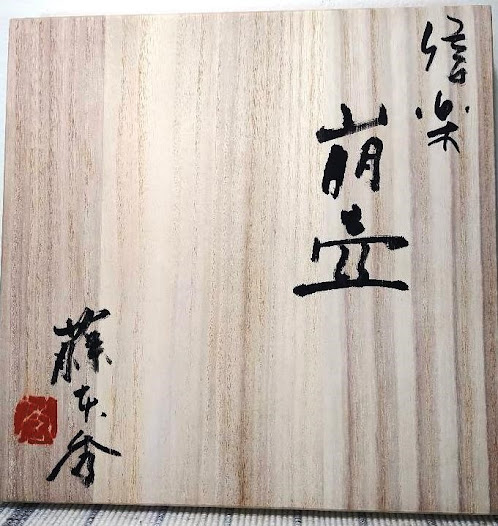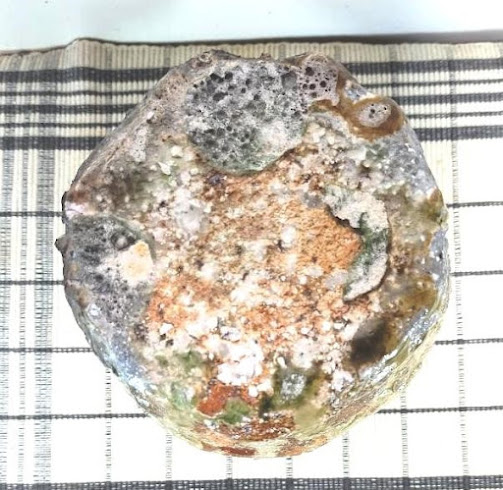262. FUJIMOTO Hide 藤本 秀, 1954- , Shigaraki kuzureta tsubo 信楽崩壺 (Shigaraki-ware collapsed pot)
For Fujimoto, see item no. 250.
Light gray clay, with addition of many small white pebbles (quartz or feldspar). This was fired unglazed. The surface decoration results from kiln effects—ash deposits, natural ash glazing, hi-iro (fire colors), and vitrification, with patches and drops of bidoro green glass-like glazing. Weight: 2.2 kg (4.9 lb). Height: 13.8 cm (5-1/2 in). Widths: rim, 12 cm (4-3/4 in); widest, 22.5 cm (8-3/4 in); base, 14.8 cm (5-7/8 in).
This sits on a flat base. The remnants of the five posts used to separate the piece from the kiln shelf during firing are visible on the base. The base is scored with many striations and much pitted. From the base the walls rise in a convex arc to the widest point, 7.6 cm (3 in) above the base. The piece collapsed above this point, more on one side (arbitrarily the front side), causing the mouth to sag downward on this side. The back side didn’t sag as much. It appears that this was to be a wide, relatively low jug. On the back side, there is an irregular hole surround by the remnants of a circular structure. To one side of this is another remnant, which appears to be a broken off protrusion of some sort. These may perhaps be remnants of a spout or a handle of some sort. The mouth is wide and surrounded by a beveled rim. The surface of the pot is rough and broken. In one place on the back part, the surface fell off after firing, leaving the clay body exposed.
This was fired unglazed. The back side has a dark gray ash deposit between the two remnants mention in the preceding paragraph. The upper part of the pot is covered with natural ash glazing, vitrified in places and with some bidoro green glass-like patches and a few tambo no me (green glass-like teardrops) running down the side. The lower half exhibits hi-iro in colors ranging from light red to mahogany. There are patches of vitrified cream-colored natural ash glazing on the base near the outside edge; most of the base has hi-iro colors in light red.
This came in a wooden box, inscribed by the artist in three lines: 信楽 / 崩壺 / 藤本 秀 Shigaraki / kuzureta tsubo / Fujimoto Hide (Shigaraki[-ware] / collapsed jug / Fujimoto Hide), with the artist’s seal stamped in red. Included in the box were a business card (meishi) and a short printed biography.
The seller told me that the pot collapsed during firing and that Fujimoto viewed it as work of art resulting from a collaboration between nature and ceramics. The result is appealing and intriguing, and it’s understandable that Fujimoto would preserve this rather than toss it on the scrap heap. Sometimes the unexpected happens when pots are fired, and the accidents can be serendipitous.
Purchased
from the Kura Monzen Gallery in Kyoto in September 2024, who received it
directly from the potter in summer 2024. This was part of an exhibit entitled Shōka
昇華
(“sublime”), or Modern Masters in
English, a show of fifteen currently active potters (invoice and shipping and
customs documents).


































